When you get down to it, shotguns are pretty simple, right? It’s a smoothbore tube, a (usually) tubular magazine, a stock, and we pretty much call it a day. Well, we’d like to, but to be perfectly honest, no one ever innovated by keeping things simple.
As a shotgun nerd, I embrace designs that try something different, and the SRM 1216 from SRM Arms might be the most different a shotgun can be.
The SRM 1216 is a semi-automatic shotgun that uses a roller-delayed blowback action. That’s already weird because this is the most HK shotgun that HK has never made. Two rollers built into the gun’s bolt create a delay that allows the pressure to drop before the action cycles. It’s the only roller delayed shotgun I’m aware of.
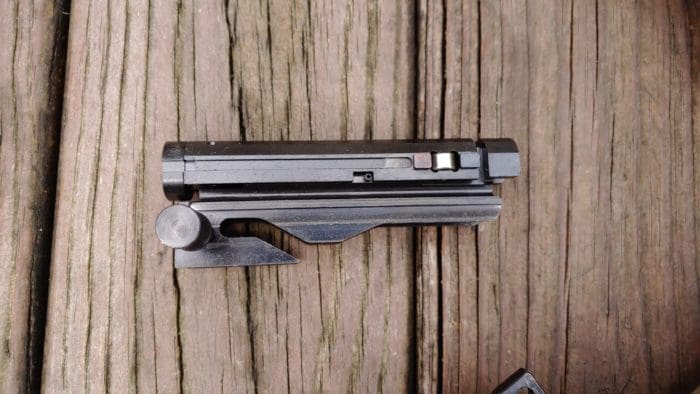
The SRM 1216 feeds from a removable magazine. That’s not too weird these days. However, it’s also a tube magazine. Well, technically it’s four tubes, all connected together. You rotate the tubes when one runs dry to bring up four more rounds. When you run dry, you can swap tubular magazines.
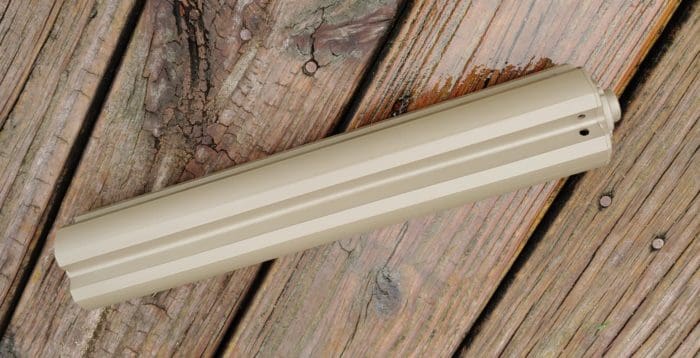
Hence the name; 12 for 12 gauge, and 16 for the capacity. Each tube houses four 2.75-inch shells. The SRM 1216 is the standard model, and if you don’t mind the tax stamp, there are short barrel models with 13-inch and 10-inch barrels (and lower capacities).
The SRM 1216 From the Outside In
At only 33 inches long, the SRM 1216 provides a shotgun that’s plenty capable for home defense. It’s six inches shorter than a Mossberg 500 with an 18.5-inch barrel. It also offers a total capacity that blows most shotguns out of the water and doesn’t require a finicky box magazine.
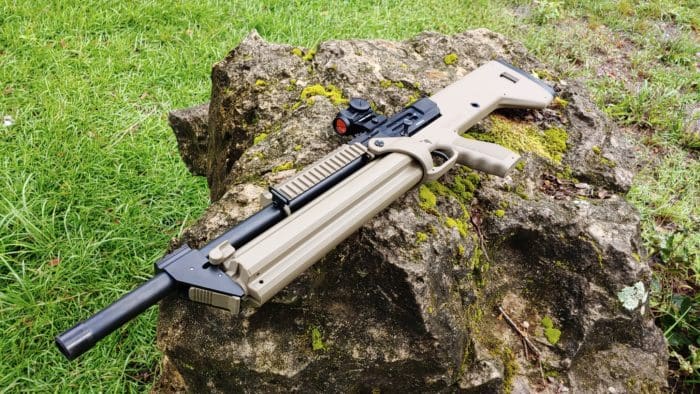
The SRM 1216 features a polymer stock and a steel upper receiver complete with a tri-rail system for accessories. Obviously, optics are the main concern, but you can also mount lights, lasers, cup holders, and the like. A final rail section sits forward of the rest of the gun to increase iron sight radius if you go that way.
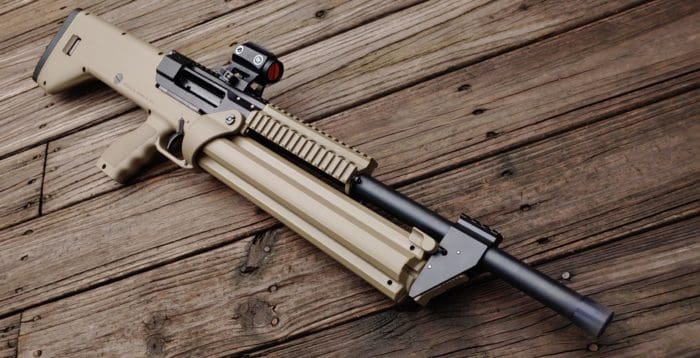
The safety is an AR-type design. My SRM 1216 features a left-side charging handle and a right-side bolt lock/release. While not detailed in the manual, the SRM Arms Youtube channel has a guide on how to switch everything to a left-handed design.
You can swap the charging handle, safety, ejection, and bolt lock to a left-handed configuration. It’s a fairly involved and lengthy process but can be done with some basic tools.


You can also just order the SRM 1216 in the configuration you want. SRM Arms can ship you a right-handed handle, a left-handed model, or some combination of whatever left- and right-handed features you want. A California variant also exists that requires a tool to remove the magazine. Since the magazine is four separate tubes, you’re not stuck with just ten rounds for less free states.
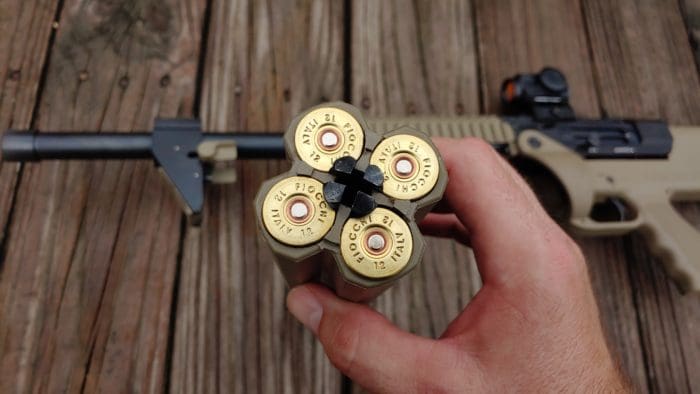

I love the left-side charging handle. I can work the action without moving my firing hand, and I don’t know why other shotgun companies don’t produce left-side or reversible charging handles. The bolt lock/release is also positioned perfectly for a quick and easy release. Press it forward with the trigger finger and the bolt snaps shut.
That Magazine Setup
The SRM 1216’s magazine is quite unique. You get 16 rounds, and if necessary, you can swap mags on the fly. Mag swaps aren’t AR-15 fast, but they’re not difficult either. At the front of the gun, just forward of the magazine is a tab that’s easy to press to remove the magazine.
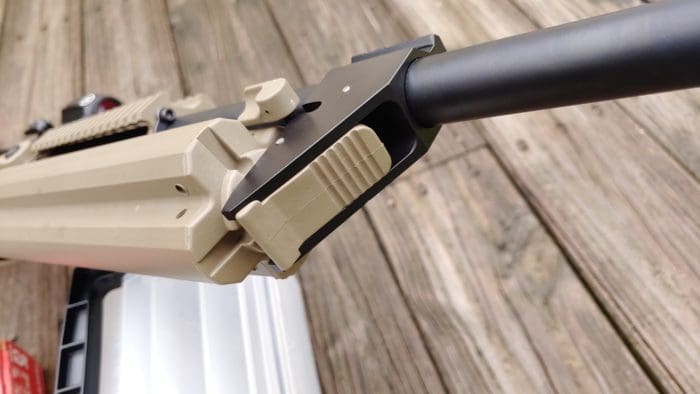

Installing the next magazine requires you to set the magazine in the rear port and then push it up to lock it in. It’s not tough to do, but it’s different and requires some practice to really master. While I love the idea of removable tubular magazines, I doubt I’d ever had to reload in a home defense situation after 16 or 17 rounds with a +1 of buckshot. That all being said, I love having the capability to reload with a whole tube even if I never need to use it.


It’s also a bit of a must because you can’t top off the four tubes when loaded in the gun. You have to manually push a shell retainer out of the way to load the tubes. You have to do this for every round, and it requires both hands to do so. It’s not fast, but it’s not hard to do or super slow by any means.
SRM’s animation helps to visualize the 1216’s operation.
Blasting Away At the Range
Now, 800 words later, we finally find ourselves at the range. None of the cool features listed above matter if the gun doesn’t go bang.
Cool and unique semi-auto shotguns tend to have issues with reliability. I can’t lie and say I wasn’t a little nervous. I had gotten my hopes up and wanted it to succeed.
I brought a box of heavy-duty birdshot with a 1,350ish FPS rating, alongside some basic 2.75-inch buckshot, some reduced recoil Flitecontrol, and finally, some super cheap birdshot game loads.


I worked through my ammunition in the order listed above. I fired 400 rounds over two days and had only two failures. The first was a failure to extract and eject because, just for fun, I used a trap/skeet load from Winchester that’s 980 feet per second. Believe it or not, the first round cycled fine, but the second didn’t. I don’t count that as a real failure since those lite rounds won’t really work with any semi-auto shotgun.


The second failure I induced purposefully. The SRM 1216 website advised not to apply rotational force to the magazine while locked and firing. It’s a rotating magazine, so I can see the issue. But I wanted to see how much pressure it took to torque the magazine enough to cause a failure.


I fired four rounds and with each one, I increased rotating pressure on the magazine. It took a surprising amount of pressure to get the round to fail to feed. The pressure applied would be difficult to do accidentally and feels incredibly unnatural.
Overall the SRM 1216 didn’t break my heart. Even the cheap Monarch birdshot cycled without complaint, and I was pleased.
That 12 Gauge Recoil
Semi-auto shotguns often have the benefit of taking some bite out of 12 gauge recoil. They are typically a lot more comfortable to shoot than pump guns. However in a smaller, lighter frame, the recoil is right there.
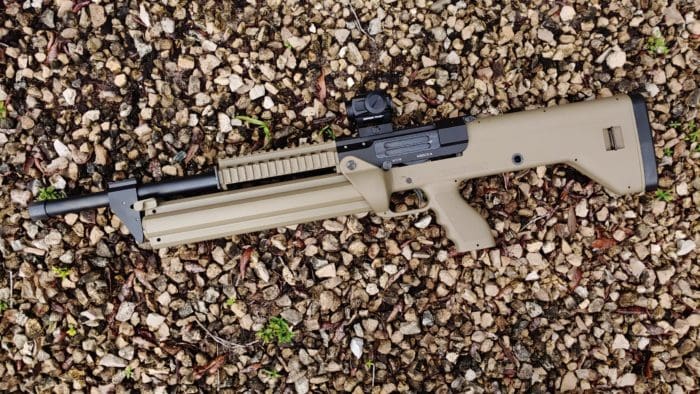




The bullpup-ish design does mitigate muzzle rise surprisingly well, which I appreciate. Fast follow-up shots make it easy to spin out double taps and destroy paper targets. In fact, we might as well not even use paper targets and stick to steel. After a single magazine, your paper targets are gone.
Ergonomics in Action
So how does that 16-round rotating tubular magazine system affect ergonomics? While it’s a bit heavy, it doesn’t toss the gun off balance. The magazine can be rotated clockwise or counterclockwise, and a set of ambidextrous tabs simply need to be pressed up to allow the magazine to rotate.


Once you run a tube dry, the bolt locks to the rear. When you rotate a fresh tube in place, the gun will automatically close the action and load a round in the chamber. It makes transitioning between tubes seamless and simple.
If you use a push/pull method for recoil mitigation, you’ll feel your hand slide a bit. I might add some skateboard tape to the magazine to improve the grip.
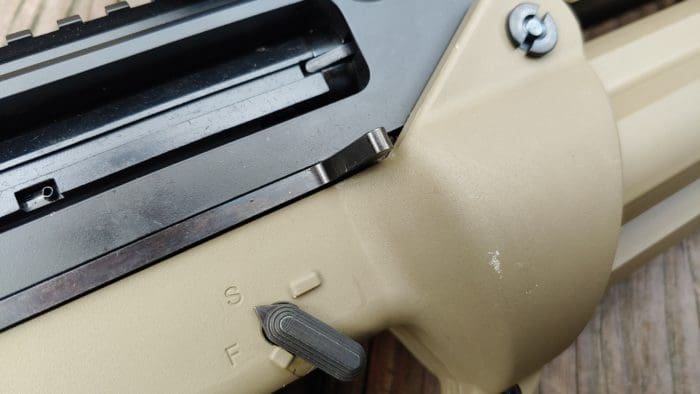

The left side charging handle and right side bolt lock make the gun very simple to use. A 13.25-inch length of pull makes it roughly A1 stock length and is plenty comfy and far from being too long. Lots of shotguns utilize a length of pull that’s much too long for anything other than wing shooting. The SRM 1216 avoids that. Also, at 7.75 pounds, the gun isn’t hefty by any means.
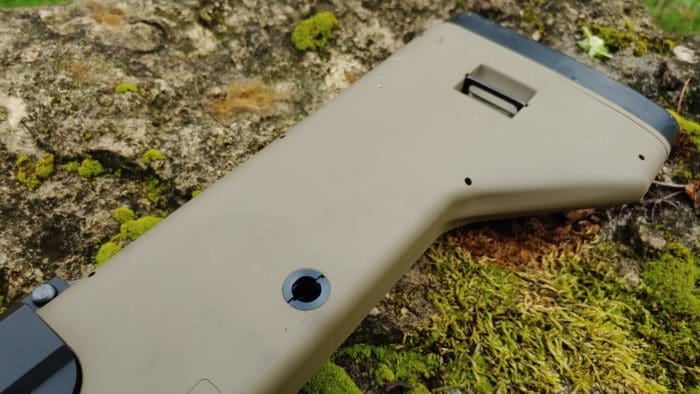

It’s a well-thought-out design that works well ergonomically.
Home Defense Ready?
Sixteen rounds of Federal Flitecontrol is a mighty load for home defense. If a group of ninjas comes at me, I’m well prepared to deal with them. I feel confident engaging home invaders, ninjas, dinosaurs, and Alfred Hitchcock’s birds should that ever come to pass.
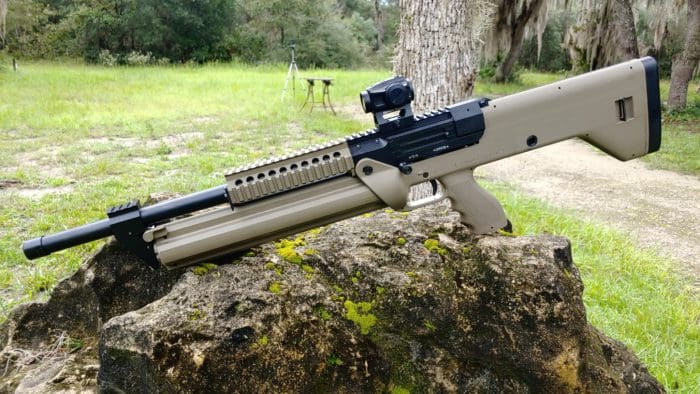

The SRM 1216 provides an ergonomic, above-average capacity shotgun with a unique design. The reliable semi-auto action makes it easy to disperse lead with little effort. I think this is a great gun. The biggest downside is the cost of extra magazines…roughly $200 a pop. Other than that the SRM 1216 is a fantastic shotgun.



Specifications: SRM Arms SRM 1216 Shotgun
Overall Length: 33 inches
Barrel Length: 18.5 inches
Length of Pull: 13.25 inches
Weight: 7.75 pounds
Capacity: 16 + 1 rounds
Caliber: 12 gauge 2.75 inch and 3 inch compatible
MSRP: $1799
Ratings (out of five stars):
Ergonomics * * * * ½
My one ergonomic complaint comes from the tubular magazine acting as a forend. A little texturing would keep your hand from slipping. I’m nitpicky, and I think SRM Arms did one helluva job designing the SRM 1216 and making it ergonomic to boot.
Accuracy * * * * *
Well, it’s a shotgun, so it’s tough to be inaccurate. However, I did use slugs out to 50 yards and made consistent headshots with the smoothbore blaster. The 6ish pound trigger is surprisingly nice for a bullpup.
Reliability: * * * * *
I debated taking a star off for the rotational force issue with the magazine but hesitated. Should user-caused malfunctions count against a gun’s reliability? If I put my thumb in the way of an AK charging handle and try to fire it, is it the gun’s fault? Transmitting enough force to cause a failure was hard to do and seems only possible when forced.
Ease of Use: * * * * *
This review is long enough, but given its unique design, the SRM 1216 is very easy to use, clean, and take down.
Overall * * * * *
While expensive, the SRM 1216 is a fantastic shotgun. It’s a very well-made and well-thought-out design that uses a unique magazine system that mixes the best features of a tubular mags with removable magazines.




I like innovation, and I like this gun’s capacity of 16 shells at semi-auto. Nice. But I don’t see the ability to top off on the fly. If I’ve shot some rounds off from my 870’s 6-shell tube and have a pause, I can top off before the next drill (similar to a tac reload for a real emergency). I don’t see the ability to top off here.
So for that reason alone, I’ll pass on this one.
Man, if you’re in a gunfight that requires more than 16 rounds of 12 gauge you’d better call in air support.
John Wick 😉
you want to top off? Drop the magazine and load in a fresh set of 16 rounds.
Exactly
Exact same thought. If I’m constantly loading, I know there’s always at least one round left. I don’t want to have to keep track of how many times I fired since I last rotated the tube.
Seriously? That would be that much of a situation for you to keep track of your firing count? Oh hey here’s an idea…just keep pulling the trigger until it doesn’t go bang anymore, drop the tube mag and load your next pre-loaded 16 round tube magazine! Just a thought! Smh man lol the excuses to NOT want this gun are just asinine. This gun is amazing and if not for such a hefty price tag I’d be all over owning one.
The shotgun S&W should’ve made. This has been out some 10 years. Cool😎
I like the IWI model better myself, I think.
I’m a little surprised there was no mention of it. The magazine design looks like a direct copy of the TS12’s.
The SRM 1216 came out in 2011 well before the IWI TS 12. The TS12 also did not run well when I reviewed it years ago.
That’s interesting, I had no idea. Also another thing I would’ve expected to see in the review since the TS12 is significantly higher profile.
Looks and functions like a shotgun from Call of Duty Black Ops 2.
Shotguns are the BEST gun there is for self defense.
I myself have a lot of different types, the combat shotties are my favorite.
I have semi’s / pumps/ & even break open typs,
For defense & close quarters, their is no comparison.
Not only that, a LOT of birds & predators have met their demise because of me & my shottie. WORD…!
I’m just guessing that over time the plastic tabs will break or wear out.
Neat idea , and I like shotgunms.
Want one.
YEah, me too, but at $1,800 it’s pretty far down the list. If I’m spending that on a gun, it’s gonna be a classic.
“I used a trap/skeet load from Winchester that’s 980 feet per second. Believe it or not, the first round cycled fine, but the second didn’t. I don’t count that as a real failure since those lite rounds won’t really work with any semi-auto shotgun.”
I’ve got a Super-X 1 that would run all day on 7/8 ounce low velocity Winchester featherlite target loads, somehow. It was actually unnerving.
“The 6ish pound trigger is surprisingly nice for a bullpup.”
That’s because it isn”t a bullpup. The action is above the trigger. Maybe a little further back than typical, but definitely not behind. Since it’s not far from the trigger, it doesn’t need the rods and linkages that make bullpup triggers mushy.
Good review. Is this a fixed choke barrel or does have screw in chokes?
Is this an updated version of the SRM 1216? I followed this closely when it first came out, but was ultimately scared away by all the reliability complaints that were reported for those first several years. Thanks for the thorough review.
So as I understand it to change from one 4 round tube to the next you manually turn the four-tube magazine assembly?
Show me a model that does that automatically and I’ll be a bunch more interested.
Otherwise, yet another expensive curiosity (not that there’s anything wrong with that) which still fails to displace my Mossberg 500 or my Mossberg 590A1.
Also, what? No bayonet lug???
Home defense? Ninjas? This is the best gun yet for fending off large herds of shuffling, mindless, brain hungry zombies. It’s likely to be the ultimate SHTF apocalyptic zombie gun.
That’s the impression I got as well from all the Youtube reviews. That’s why I went for the IWI. Also can reload on the fly and have 5 shots per tube. 16 with one chambered and supposedly two more can be in the loading staging area at the ready.
I don’t like having to grip a magzine to hold on to the weapon. I’m sure it isn’t all that tight and what happens if somehow the mechanism loosens so that you no longer have a secure grip?
There should be something extending from the upper receiver or from the rear so that your handle on the firearm is to a solid part of the frame and not a removable part such as the magazine. It’s also begging for stresses to be taken up by the magazine and the mechanism to rotate the magazine which will not be a good thing in the long run.
And for the price they should’ve thought of stuff like that. This is a gimmick.
Counterpoint: Get something magazine fed. Props for doing something creative but the rotating tubular magazines is a major point of weakness from my perspective. I tend to look at things in terms of: how will it worked under stress. The less fine motor actions you have to take when fighting the better. Why is it a good idea to hope the user doesn’t over-torque the tube.
It’s a nice clean design and 16 rounds is impressive but I view it as really being 4-rounds-and-a-mag-change X 4. It saves some steps but still complex as compared to topping off as you go and fast mag changes, which are established and combat proven procedures.
I love the innovation. I also love delayed roller blowback and think it’s really cool someone made it into a shotgun.
“Once you run a tube dry, the bolt locks to the rear.”
Could you explain how that part operates? I’m pretty interested as I always thought delayed roller blowback systems couldn’t have a bolt lock. But obviously that has now been done.
Someone tell the author they are called shotgun SHELLS not rounds. A woke PFC knows the difference.
And as usual I have to complain that they do not apparently make one chambered for 20 gauge. Not only does 20 gauge reduce the recoil, it also reduces the diameter of that FAT four-tube rotary magazine.
While I understand the appeal of 12 gauge for shooting #00 buckshot (which carry 9 pellets per shell in standard 2 3/4-inch shells) rather than 20 gauge shooting its downsized equivalent (which would be, what, 9 pellets of #1 buckshot per shell?), any size of buckshot rapidly becomes a liability with distance in a self-defense situation. That buckshot pattern opens rapidly with shorter barrels (and likely no chokes) to the point that your pattern would be on the order of 10 inches at 30 feet, 20 inches at 60 feet, and 30 inches at 90 feet. Those large patterns increase the probability of hitting bystanders and reduce the probability of quickly incapacitating an attacker (since relatively few pellets would hit an attacker).
I am in the camp that a shotgun slug would be superior to buckshot pellets in almost every scenario. And once you gravitate to slugs over buckshot, it makes no difference whether you are launching a 12 gauge (.73 caliber) slug or a 20 gauge (.62 caliber) slug into an attacker–either one will promptly incapacitate him/her at any range out to 70 yards or more.
For home defense, if I wanted a single projectile I’d prefer a rifled barrel and something in 5.56. 12 gauge makes the most sense because it’s the most round with tactical loads designed for it. 20 gauge doesn’t offer loads like Flitecontrol.
12 gauge recoil isn’t that bad and I think companies realize most adults handle it fine for the amount of rounds fired for home defense. If I was shooting hundreds of shots for birds then 20 gauge might be my choice, but 12 seems perfect for dispatching home invaders ,xenomorphs, and the like.
Won’t be much of a home left to defend after 16 rounds.
美国大学论文有多种形式,如研究论文、案例研究、文献综述等。不同类型的论文都有特定的写作方法,都需要根据学校的要求在不同的结构中进行开发。同时,很多商科和文科的课程都有大量的阅读材料,而写论文前的准备就是了解和消化这些阅读材料,这对中国学生来说是一个很大的工程。小精灵代写为留学生提供专业美国代写、美国essay代写、paper代写服务。https://lunwen.littlefairyessay.com/
Inspired from the tv series Yellowstone, this Kelly Reilly Blue Coat is poncho-style outerwear. Kelly Reilly portrayed the role of Beth Dutton, daughter of John Dutton in the series.
If you love to wear action movies and games outfits so must check the top 5 superb Cosplay Jackets which gives you a killer and stunning look on this cosplay festival.
Comments are closed.